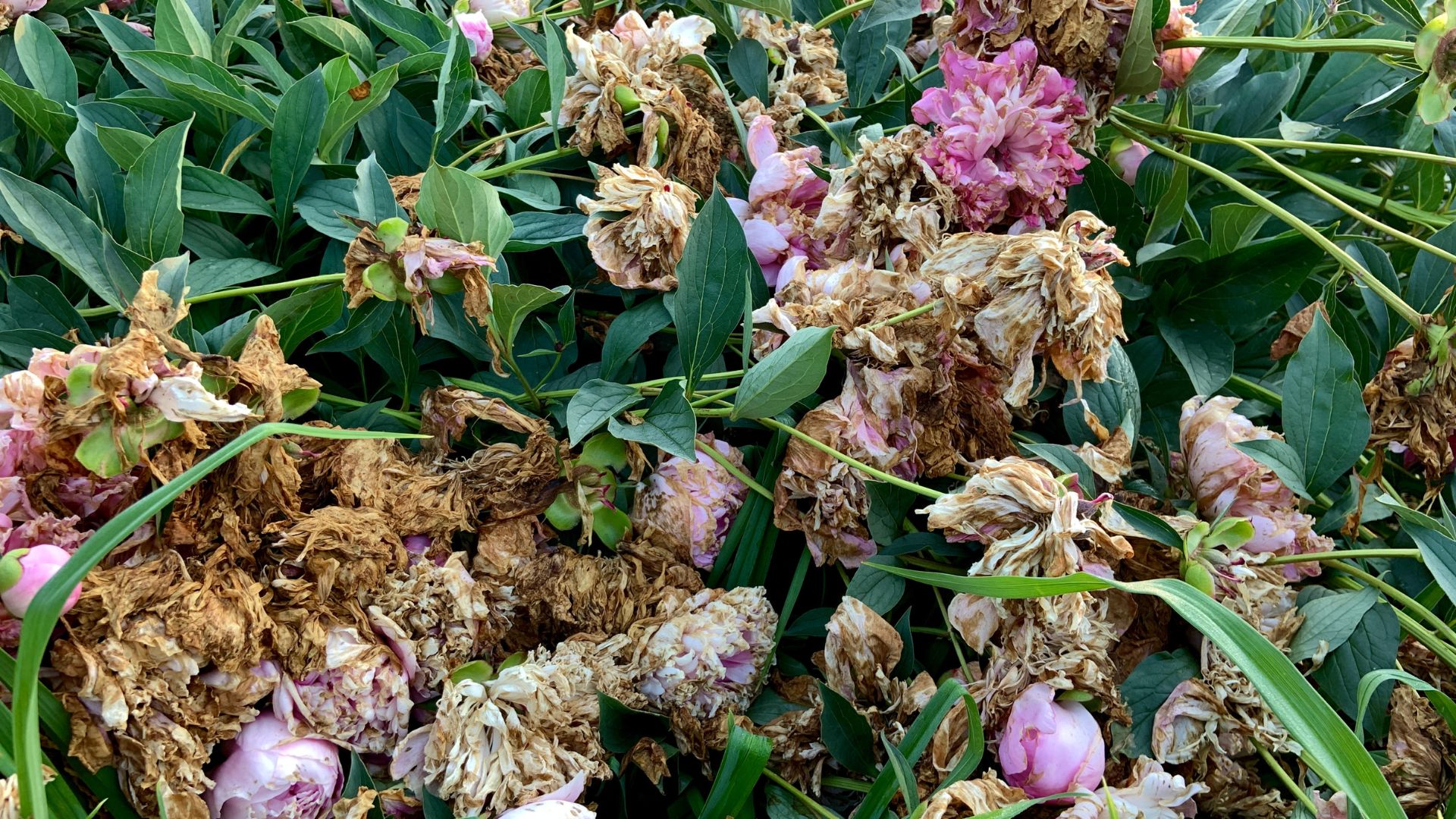Should you deadhead peonies? Garden experts reveal the secret to better blooms
Is your peony bush starting to look rather sad? We asked garden experts whether or not it's safe to tidy them up and start deadheading


If you were lucky to get an impressive peony bloom this year you might now be seeing a few flowers passing their best-by date, which may leave you asking should I deadhead my peonies?
No matter what the garden trends are this year, peonies are always going to be a popular flower to have growing in any plant collection. Knowing how to grow peonies and mastering the maintenance will give you the most beautifully rewarding blooms.
On that note, when it comes to the end of spring, fully bloomed peony bushes can start to wither and look a little tatty. Which begs the question: Should you deadhead peonies?
We've consulted with garden experts to uncover whether it's good for the plant's health or if it's best left undone.
Should you deadhead peonies?
When it comes to the various garden plants you should never deadhead, do peonies belong on the list? Well, whilst you may be reluctant to attack your peony bush with a pair of secateurs, there is no need to fret.
"I’d say that deadheading is a very important peony maintenance practice, specifically if you want to improve their appearance and get more blooms the following year," explains Peter Ivanov, gardening expert at Fantastic Gardeners.
Peter does, however, point out that this rule does differ depending on the type of peony you have growing in your garden.
Sign up to our free daily email for the latest royal and entertainment news, interesting opinion, expert advice on styling and beauty trends, and no-nonsense guides to the health and wellness questions you want answered.

"There are 3 varieties of peonies, which is important to keep in mind when considering if you should deadhead your plant," he explains. "The first one dies back to the ground in winter. The second one, known as 'tree peonies', is taller and more woody and doesn’t die during winter. The third variety is a cross between the first two, but it’s not very easy to find."
For the peony that dies back in winter, Peter recommends cutting it completely down to ground level in the autumn, whilst tree peonies don't require any type of pruning.
For tree peonies, Peter suggests removing faded seed heads from their stems. So yes, if you have one of these species, it's very important to deadhead them.

Peter has been a gardening and plant expert at Fantastic Gardeners for over 8 years, he is now one of the company's top-performing experts and manages over 6 teams of gardeners. He works on creating stunning landscapes and prioritises sustainability in his gardening methods.
What are the benefits of deadheading peonies?
Similar to the benefits of pruning an olive tree and what to do with crocuses after flowering, deadheading your peonies can make a huge difference in the plant's short-term and long-term health.
Tatiana Sergeenko, owner of Floritta Flowers and seller at Flowwow, explains that deadheading your peonies will stimulate the plant's growth and extend the flowering period – a reason to time when to prune lilacs also.
She says, "When you cut the flower, you also conserve its energy, for seed formation, which affects the growth of the plant. It's not only important to prune the flower but also to remove any rotted petals, as this reduces the risk of disease in the flower."
It's also important to keep on top of your plant's seeds, as a simple gust of wind could also spread diseases from one plant to another in your garden. So whilst you may have got rid of the leatherjackets in your garden, your unruly peony bush could cause you a whole new pest problem.

With over 10 years as a florist, Tatiana has a wealth of knowledge on the maintenance and styling of various plant species. She owns Florrita Flowers, a luxury floristry that offer bespoke fresh flower boquets, including peonies and tulips.
How to deadhead peonies
Now you have the all-clear to deadhead your peonies, what's the best way forward? Whilst it isn't dissimilar to how to prune a rose bush, there are a few differences in the steps when it comes to a peony bush.
"Deadheading peonies is a simple practice that involves removing the spent flowers. Still, you’ll need to know when the right time to perform this task is," says Peter. The ideal time for deadheading is when you begin to notice that your peony blooms have started to fade and fall away.

The time frame for this is usually late spring or early summer, however, the exact timing depends on the variety of peonies you're growing. Peter says that you'll also need to consider the weather besides the timing.
He explains, "The ideal conditions will be a dry and sunny day and when the plant isn’t wet from rain or dew. This is important to prevent any spread of disease."
Once you've chosen the right time, learning how to deadhead your plant properly is rather simple. Whilst you may use your hands for deadheading other plants, Peter recommends using clean gardening scissors, secateurs or pruners and cutting the spent flowers to a set of healthy leaves or right above the leaf node.
A good pair of secateurs or pruners is one of the essential tools every gardener needs to get more done.
Shop deadheading essentials

RRP: £24.00 | Ideal for cutting tougher stems, these loppers have durable, rust-resistant, carbon steel blades and an extendable mechanism. They're a particularly useful tool for more established peony bushes.

RRP: £8.49 | These gardening gloves have been awarded ‘Amazon’s Choice’, and it’s easy to see why – they’re breathable, comfortable, and stylish.

RRP: £11.95 | These popular secateurs feature a carbon steel blade and lightweight, non-slip handles, making precision pruning and deadheading easy.
FAQs
What happens if you don't deadhead peonies?
So what happens if you forget to add deadheading your peonies to your list of essential summer gardening jobs?
“If you don’t deadhead your peonies, the spent flowers will remain on the plant and eventually form seed pods. While this doesn’t usually harm the plant, energy that could be used for root development and next year’s growth goes into seed production instead," explains Luke Newnes, gardening content creator and member of Interior Squad at Hillarys.
He adds, "The plant can also look a bit untidy with faded blooms left on. Deadheading helps keep your peonies looking their best and can sometimes encourage a bit of extra growth.”

Joining the Hillarys Interior Squad, Luke—also known as The Pink Gardener—is a new-build gardening specialist and content creator. With a talent for transforming outdoor spaces, he shares expert gardening tips and inspiration. When he’s not making digital content, Luke works at a garden centre, where he continues to share his knowledge and enthusiasm for gardening and the outdoors.
How do you keep peonies blooming all summer?

If you want your peonies to stick around with your late summer flowers, you might be a little disappointed to know they're not likely to last longer than a few weeks.
"The best way to enjoy blooms for as long as possible is to plant a mix of early, mid, and late-flowering varieties, so you get a succession of flowers. Deadheading spent blooms promptly keeps the plant tidy, but unfortunately, it won’t make the same peony plant keep flowering all summer," suggests Luke.
When you've tackled deadheading the flowers, Tatiana says to make sure all peony remains are properly discarded so as not to attract any unwanted pests. Why not add them to your homemade compost heap?

Emily joined woman&home as a staff writer after finishing her MA in Magazine Journalism from City University in 2023. After writing various health and news content, she now specialises in lifestyle, covering unique cleaning hacks, gardening how-tos, and everything to help your houseplants thrive.